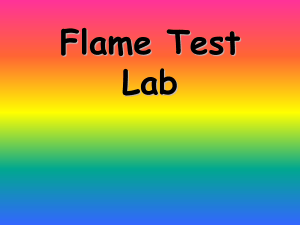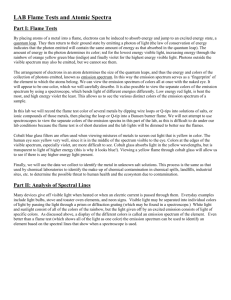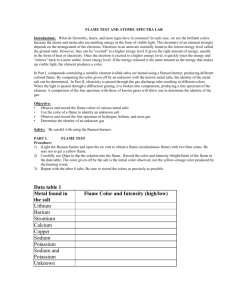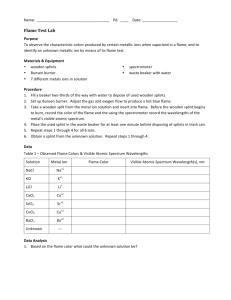Flame Test Lab Instructions
advertisement
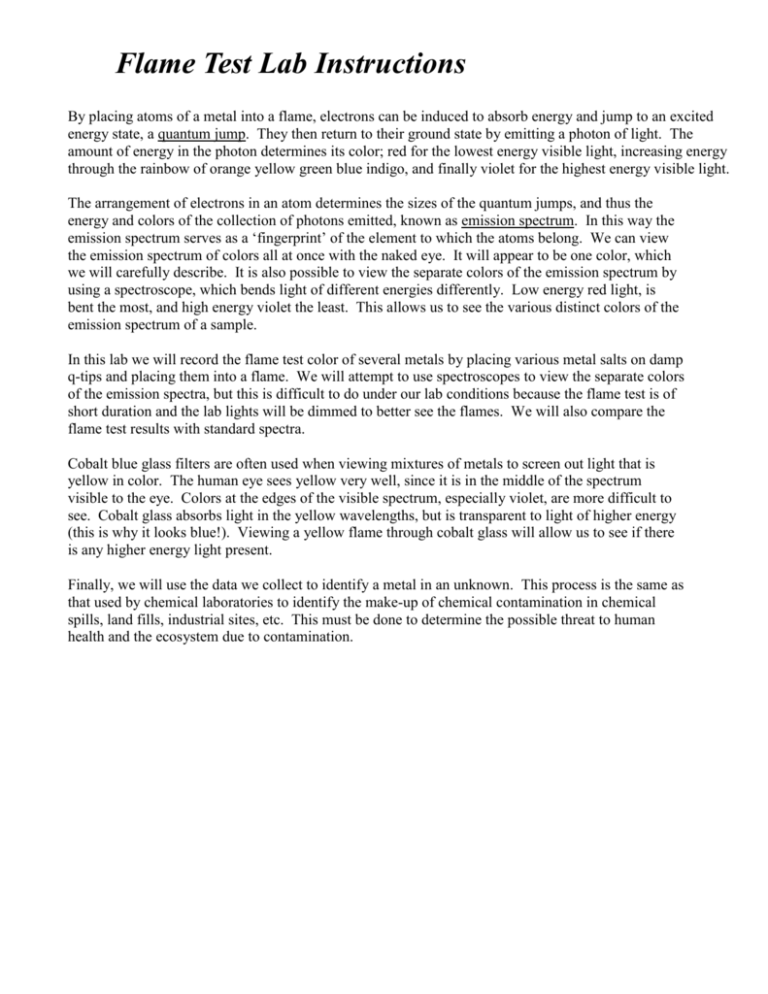
Flame Test Lab Instructions By placing atoms of a metal into a flame, electrons can be induced to absorb energy and jump to an excited energy state, a quantum jump. They then return to their ground state by emitting a photon of light. The amount of energy in the photon determines its color; red for the lowest energy visible light, increasing energy through the rainbow of orange yellow green blue indigo, and finally violet for the highest energy visible light. The arrangement of electrons in an atom determines the sizes of the quantum jumps, and thus the energy and colors of the collection of photons emitted, known as emission spectrum. In this way the emission spectrum serves as a ‘fingerprint’ of the element to which the atoms belong. We can view the emission spectrum of colors all at once with the naked eye. It will appear to be one color, which we will carefully describe. It is also possible to view the separate colors of the emission spectrum by using a spectroscope, which bends light of different energies differently. Low energy red light, is bent the most, and high energy violet the least. This allows us to see the various distinct colors of the emission spectrum of a sample. In this lab we will record the flame test color of several metals by placing various metal salts on damp q-tips and placing them into a flame. We will attempt to use spectroscopes to view the separate colors of the emission spectra, but this is difficult to do under our lab conditions because the flame test is of short duration and the lab lights will be dimmed to better see the flames. We will also compare the flame test results with standard spectra. Cobalt blue glass filters are often used when viewing mixtures of metals to screen out light that is yellow in color. The human eye sees yellow very well, since it is in the middle of the spectrum visible to the eye. Colors at the edges of the visible spectrum, especially violet, are more difficult to see. Cobalt glass absorbs light in the yellow wavelengths, but is transparent to light of higher energy (this is why it looks blue!). Viewing a yellow flame through cobalt glass will allow us to see if there is any higher energy light present. Finally, we will use the data we collect to identify a metal in an unknown. This process is the same as that used by chemical laboratories to identify the make-up of chemical contamination in chemical spills, land fills, industrial sites, etc. This must be done to determine the possible threat to human health and the ecosystem due to contamination. Pre-lab Questions: Answers before you begin the lab. 1. What color of light is lowest in energy? What is highest? 2. What is the purpose of a spectroscope? 3. How can cobalt blue glass help us to see violet and blue light? 4. If you test two samples and find that both produce a red flame, how can you determine for sure whether they contain the same metal? 5. Most salts contain a metal and a non-metal. Look at the compounds we will test and determine how we can be sure that it is the metal atoms that emit the photons and not the non-metal. 6. List the colors of the visible spectrum in order of increasing wavelength. 7. What is meant by the term frequency of a wave? What are the units of frequency? Describe the relationship between frequency and wavelength. DATA TABLE Metal Lithium Li1+ Sodium Na1+ Potassium K1+ Calcium Ca2+ Barium2+ Strontium2+ Copper2+ Sodium (cobalt glass) Potassium (cobalt glass) Unknown 1 = Unknown 2 = Unknown 3 = Description of Solution Flame Color Questions 1. List the colors of the visible light spectrum in order from lowest to highest in energy level. 2. List the metals you tested in order of increasing energy (based on the light emitted when heated). 3. What was the purpose of using the cobalt glass in the identification of sodium and potassium? Post- Lab Questions: Report your findings regarding… 1. List the metallic elements used in the flame test in increasing order of the energy of the light emitted. 2. Predict what metal was present in your unknown. Explain how you came to this conclusion. 3. Calculate the wavelength of the yellow light emitted by a sodium lamp, in meters, if the frequency of the radiation is 5.10 X 10 14 /sec. 4. What is the energy of a photon of green light whose frequency is 6.58 X 10 14 /sec? 5. A glass rod was heated in a burner flame and gave off a bright yellow flame. What metal ion predominates in the glass rod? 6. The alkali metal cesium (Cs) and rubidium (Rb) were discovered on their characteristic flame colors. Cesium is named after the sky and rubidium is named after the gem color. What colors of light do you think these metals give off when heated in a flame? 7. Whether it is the metal or the non-metal that produces the flame test color. 8. Identity of the unknown (it is one of the metals you tested) 9. If you had 2 colors that seemed identical, how could you tell them apart more accurately? (Questions continued on the next page) 10. Albert Einstein determined this equation: Energy (in joules) of a photon is equal to Planck's constant times the frequency of the light: E = hv Frequency (v) has units of 1/sec (which is a Hertz, or Hz) Planck's constant (h) = 6.626 x 10 -34 J·sec a) If the frequency of a red spectrum line is at 1.60 x 10 14 Hz, how much energy does each photon of this light have? b) If the frequency of a violet spectrum line is at 2.50 x 10 14 Hz, how much energy does each photon of this light have? c) On the far ends of the visible spectrum of light, there exists ultraviolet (UV) radiation and infrared (IR) radiation. - UV radiation is dangerous. UV radiation is located just past violet on the spectrum. - IR radiation is harmless. It is located just past red on the spectrum. Based on what you calculated in parts a & b, explain -why- UV is more dangerous than IR: 11. Over 100 years ago, light from the sun revealed an element later discovered on Earth. What is it’s name and chemical symbol? (Hint: the Greek word for “sun” is helios.) 12. Use the image below to view the spectra of calcium (top) and sodium (bottom). Solve for frequency and energy of the brightest emission line for each element. Use the brightest lines. Show your work and record your answers on the Data Table.
